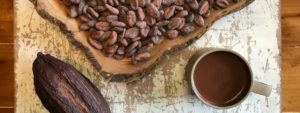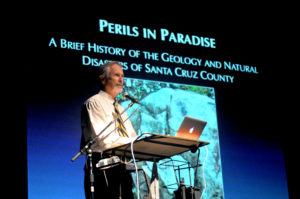We live in a foodie culture. Intellectual fascination with the ingredients, techniques and traditions surrounding food has exploded in this era of celebrity chefs, farm-to-table restaurants, and highly creative handcrafting of everything from jam to beer. Inspired by this enthusiasm and our regional bounty, the Museum has dedicated public programming in February and March to exploring the natural history of food.
Following February’s Naturalist Night talk on organic farming principles, State Park Ranger Alex Tabone joined Rick Flores, Curator of California Native Plant Collection at the UC Santa Cruz Arboretum and Associate of the Amah Mutsun Land Trust, for a special workshop on native foods and preparations. We were also so grateful to have Chairman Valentin Lopez from the Amah Mutsun Tribal Band honor us with his presence and cultural insights. The engaged audience watched demonstrations of the traditional, indigenous methods of preparing manzanita cider, roasted soaproot, roasted grass seeds, and acorn porridge.
March is equally bubbling over with food-related events. We have two Naturalist Nights this month dedicated to further exploring the natural history of food and how we connect to it:
 On March 21st, the Museum is partnering with Mutari Chocolate, to reveal what it takes to make a delicious cup of the ultimate comfort drink, hot chocolate. During the “Bean to Cup” presentation, Mutari’s owners, Katy Oursler and Stephen Beaumier, will educate us about the origins and history of chocolate making. Then they will lead us in a guided tasting of their delicious sipping chocolate!
On March 21st, the Museum is partnering with Mutari Chocolate, to reveal what it takes to make a delicious cup of the ultimate comfort drink, hot chocolate. During the “Bean to Cup” presentation, Mutari’s owners, Katy Oursler and Stephen Beaumier, will educate us about the origins and history of chocolate making. Then they will lead us in a guided tasting of their delicious sipping chocolate!
Then on March 30rd, the leaders of the Santa Cruz Heritage Food Project — Sierra Ryan, Liz Birnbaum, Jody Biergiel Colclough and Katie Hansen — will bring us up to speed on more than four years of research into the stories behind local foods such as beets, berries and wine grapes. And we’re very excited to welcome the Teen Kitchen Project for a special food demonstration before the talk.
Santa Cruz is synonymous with a menu of culinary delights — from pop-up restaurants to small-batch artisanal foods emphasizing local ingredients. We hope that this month you will join us in connecting to the natural history of some of our favorite foods and seeing them in a whole new way.
Thank you,
Heather
![]()


 At Santa Cruz Memorial Cemetery, Mayor Cynthia Chase read a proclamation from the City of Santa Cruz designating January 29th as Laura Hecox Day. And I had the opportunity to talk about the love Laura had for the natural world, collecting shells, and other specimens and artifacts that formed the basis of our Museum, which opened in 1905 while she was still our city’s lightkeeper. Laura’s life served as inspiration for the Santa Cruz Naturalist exhibit that opened in June 2016, the first new permanent addition to the Museum’s galleries in over 20 years.
At Santa Cruz Memorial Cemetery, Mayor Cynthia Chase read a proclamation from the City of Santa Cruz designating January 29th as Laura Hecox Day. And I had the opportunity to talk about the love Laura had for the natural world, collecting shells, and other specimens and artifacts that formed the basis of our Museum, which opened in 1905 while she was still our city’s lightkeeper. Laura’s life served as inspiration for the Santa Cruz Naturalist exhibit that opened in June 2016, the first new permanent addition to the Museum’s galleries in over 20 years. After the graveside ceremony, the Museum led a clean-up project in Lighthouse Field. Laura moved to Lighthouse Field at age 15 when her father assumed the role of the first lightkeeper of the then-new Santa Cruz Lighthouse. She took over her father’s position after his death and continued in that role through most of her life, living in the original lighthouse. Today, in its place, the Mark Abbott Lighthouse now guides vessels around Lighthouse Point. But the field across from West Cliff Drive remains open space full of opportunities to explore. About three dozen volunteers collected over 100 pounds of trash from the field, which was a particularly fitting way to honor Laura and her commitment to stewarding the natural world.
After the graveside ceremony, the Museum led a clean-up project in Lighthouse Field. Laura moved to Lighthouse Field at age 15 when her father assumed the role of the first lightkeeper of the then-new Santa Cruz Lighthouse. She took over her father’s position after his death and continued in that role through most of her life, living in the original lighthouse. Today, in its place, the Mark Abbott Lighthouse now guides vessels around Lighthouse Point. But the field across from West Cliff Drive remains open space full of opportunities to explore. About three dozen volunteers collected over 100 pounds of trash from the field, which was a particularly fitting way to honor Laura and her commitment to stewarding the natural world. Dr. Griggs captivated the 550-member audience with an engaging overview of geological processes and a historical look at the most impactful natural disasters of our region, one where earthquakes, landslides, floods, fires and other calamities are an ever-present danger. As several storms wreaked havoc across the county on local cliffs, tributaries and roads, Dr. Griggs’ presentation served as a timely reminder that landmark events such as the 1955 and 1982 floods, or the 1989 Loma Prieta earthquake, have long shaped our region and that we cannot control nature. That’s a key reason the Museum exists — to share an understanding of the awesomeness of nature and inspire stewardship of it.
Dr. Griggs captivated the 550-member audience with an engaging overview of geological processes and a historical look at the most impactful natural disasters of our region, one where earthquakes, landslides, floods, fires and other calamities are an ever-present danger. As several storms wreaked havoc across the county on local cliffs, tributaries and roads, Dr. Griggs’ presentation served as a timely reminder that landmark events such as the 1955 and 1982 floods, or the 1989 Loma Prieta earthquake, have long shaped our region and that we cannot control nature. That’s a key reason the Museum exists — to share an understanding of the awesomeness of nature and inspire stewardship of it.
 On Dec. 20, we unveiled our new entrance sign, which will be seen by the almost 20,000 visitors we welcome through our doors each year. Thousands more will see it as they make their way to nearby Seabright Beach, the Yacht Harbor or the Beach Boardwalk. The metal sign created by Santa Cruz artist Alan Ziegler features our name and logo but represents much more than just a new face to the Museum. It marks a fresh start for this precious place founded 111 years ago as Santa Cruz’s first public museum.
On Dec. 20, we unveiled our new entrance sign, which will be seen by the almost 20,000 visitors we welcome through our doors each year. Thousands more will see it as they make their way to nearby Seabright Beach, the Yacht Harbor or the Beach Boardwalk. The metal sign created by Santa Cruz artist Alan Ziegler features our name and logo but represents much more than just a new face to the Museum. It marks a fresh start for this precious place founded 111 years ago as Santa Cruz’s first public museum. In the past three years, we have seen a 15 percent increase in general admission — this does not include school groups, member visits, or special events — just the folks who popped in to see what we are all about. And I’m also very excited to tell you the number of new memberships rose 13 percent in 2016 year over 2015.
In the past three years, we have seen a 15 percent increase in general admission — this does not include school groups, member visits, or special events — just the folks who popped in to see what we are all about. And I’m also very excited to tell you the number of new memberships rose 13 percent in 2016 year over 2015. Rotating special exhibits, including two premieres: Photographer Jason Bradley’s “California: At the Water’s Edge” and local historian Frank Perry’s “Big Basin’s Auto Tree: One Tree, Many Stories.” We also had a Mobile Museum event at Lupulo Craft Beer House in October ahead of a special sold-out Museum of the Macabre event at the Museum in celebration of Halloween.
Rotating special exhibits, including two premieres: Photographer Jason Bradley’s “California: At the Water’s Edge” and local historian Frank Perry’s “Big Basin’s Auto Tree: One Tree, Many Stories.” We also had a Mobile Museum event at Lupulo Craft Beer House in October ahead of a special sold-out Museum of the Macabre event at the Museum in celebration of Halloween. In the coming year, we also will celebrate the birthday of our founder Laura Hecox on Jan. 29 by honoring a new gravestone marking her final resting place. In April, we will feature the 28th installment of our annual exhibit of scientific illustration as well as a new exhibit created by the Santa Cruz Kids in Nature program. We also will premiere a new book about the history of Seabright here in April and are proud to have been a part of this exciting publication created by the Seabright Neighborhood Association.
In the coming year, we also will celebrate the birthday of our founder Laura Hecox on Jan. 29 by honoring a new gravestone marking her final resting place. In April, we will feature the 28th installment of our annual exhibit of scientific illustration as well as a new exhibit created by the Santa Cruz Kids in Nature program. We also will premiere a new book about the history of Seabright here in April and are proud to have been a part of this exciting publication created by the Seabright Neighborhood Association.